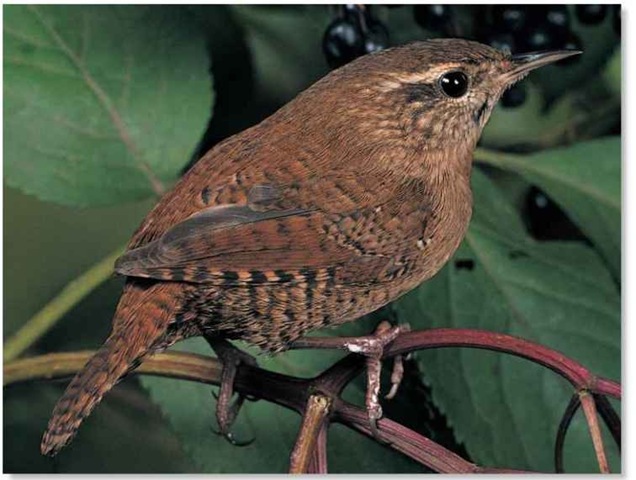ORDER
Passeriformes
FAMILY
Troglodytidae
GENUS & SPECIES
key features
One of the smallest birds in the United States, barely heavier than a wine-bottle cork Usually hard to see, remaining in dense cover where it forages exclusively on insects Vocal throughout the year, it has one of the loudest songs of all birds relative to its size
where in the world?
Across North America in winter to southern states; also in iceland and most of Europe, parts of Asia to Kamchatka in Russia and south to North Africa

LIFECYCLE
Smaller than most birds, the winter wren loses body heat rapidly, yet can survive the winter by scurrying among the undergrowth searching every nook and cranny for insects.
HABITAT
The winter wren’s habitat ranges from parks or farmland to wooded ravines and remote island sea cliffs. It survives where it can roost or nest in safety, such as on riverbanks or among vegetation,and where it can find insects in low cover.
The largest numbers occur in broad-leaved woodland with heavy understory. The only habitats that the wren avoids are large areas of bare rock, snow,sand,mud and water.The isolation of wrens on offshore islands has evolved several distinctive island races.

A Rough and ready The winter wren forages and nests in thick cover.
The winter wren’s scientific name, Troglodytes, comes from the Greek word meaning “cave dweller,” and refers to the wren’s domed nest, which has a cave like entrance.
Sixty-one individuals have been recorded roosting in a single nest box during a harsh winter.
Old country nicknames for the wren include stumpy toddy, titty todger and jenny wren.
BEHAVIOR
Because it spends most of its time slipping restlessly through dense cover, the winter wren is hard to spot. But it is not usually timid, and when washing itself in a bird bath allows humans to approach. The wren is especially noticeable when it pops up to sing on a moss-covered stump, puffing out its breast and trembling its wings,to deliver its astonishingly loud song.
The male winter wren sings throughout the year, except for a brief break in late summer to early autumn, when molting. Analysis has revealed that each burst of wren song contains over 100 separate notes. The male delivers his song at great speed, always ending the performance with a loud trill.
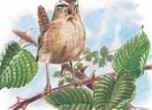
Vocal hero…
A male pours out his song from a perch to proclaim ownership of territory to other males and interested females.
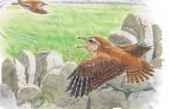
Chases…
As an intruding male arrives,the resident bird takes to the air swiftly. Amid a swirling aerial chase, he chases off the intruder.
FOOD & FEEDING
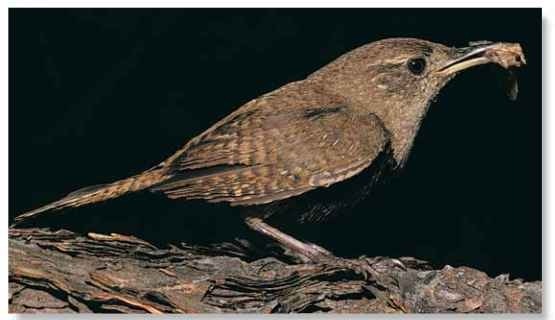
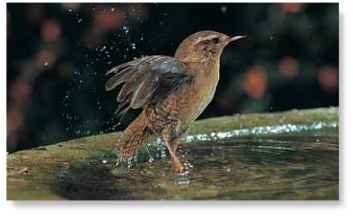
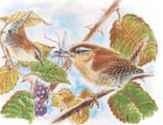
Toleration…
During autumn, when there are many young birds around, the adult male relaxes his guard and may allow others to feed nearby.
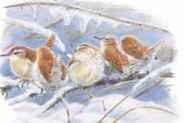
Heart warming
In severe winters, wrens put aside territorial differences and huddle together, using each other’s bodyheat to stay warm.
The winter wren forages for a wide range of insects but seems to have a preference for beetles. This diminutive bird also snaps up ants and their eggs, aphids, caterpillars various types of flies and grasshoppers. The wren also eats spiders, and may feed on millipedes, centipedes, woodlice and small snails. Occasionally, the winter wren has been observed eating tadpoles and even small fish.
When searching for prey, the wren moves quickly and jerkily, flying fast between feeding areas. Foraging close to the ground, it peers under leaves and probes bark crevices in search of prey. Its tiny, compact body enables it to slip behind ivy stems or through shrubs and brambles.
In winter, insects become scarce, and the winter wren may move into marshy areas where prey can still be found. It has become skilled at locating the semidormant pupae of moths and other insects, and may even eat seeds for energy.
Strike it lucky A slender bill extracts insects from crevices.
BREEDING
The male wren is most vocal in early spring, when his song will attract females. Although some males take one mate each season, many will mate with two or more females.
Using dead grass or leaves, moss and bracken, the male builds several nests. He hides each one well — among ivy or other creepers, in a hedge or even in the old nest of another bird. When a female shows interest, he takes her to one of his nests. If it meets with her approval, she adds a lining of feathers and lays her eggs. The male plays no role in rearing the young.
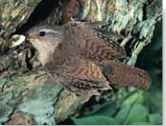
A Home removals The mother cleans the nest of fledglings’ fecal sacs so that the smell does not alert predators.
Open-and-shut case The young winter wrens feed on insects brought by their mother until they fledge at 3 weeks old.
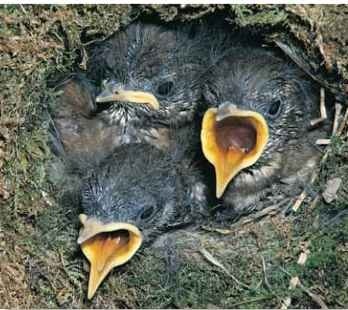
CONSERVATION
Common across most of its range, large numbers of wrens may be lost in extreme cold weather — up to 70% of Britain’s wrens have died during particularly severe winters.
Profile
Winter Wren
With its wide, gripping feet and lightweight body, the winter wren can descend easily to the ground and probe for insects using its slender bill.
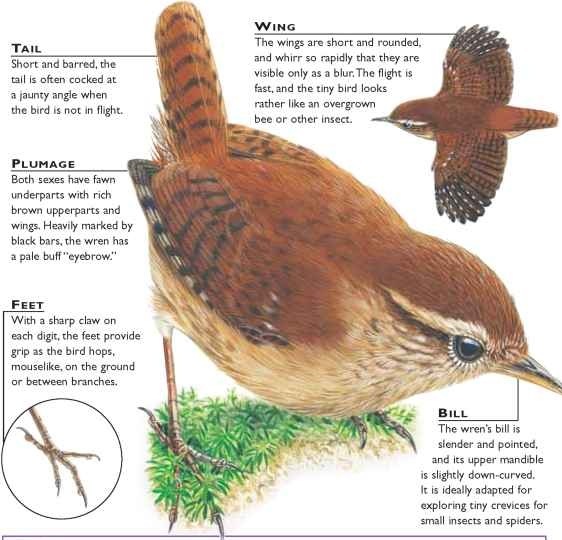
CREATURE COMPARISONS
Found in Australia, the splendid fairy-wren (Malurus splendens) is in a different family, the Maluridae. It feeds on insects in scrubland, woodland fringes and orchards. Growing to about 5.5″, the splendid
fairy-wren is slightly larger than the Shetland wren (Troglodytes troglodytes zetlandicus), a large subspecies of the winter wren.This island race is heavily barred and paler than the subspecies found in the U.S. It’s appearance cannot compete with the breeding plumage of the male splendid fairy-wren. He is all blue, with pale cheeks and a white-tipped crest divided by black eye stripes.
Splendid fairy-wren

Shetland
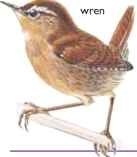
| vital statistics | |
| Weight | 0.28-0.45 oz. |
| Length | 3.6-4″ |
| Wingspan | 5.2-6.8″ |
| Sexual Maturity | 1 year |
| Breeding Season | April-August |
| Number of Eggs | 3-9, usually 5-7 |
| Incubation Period | 12-20 days, usually 15-17 |
| Fledging Period | 14-19 days |
| Breeding Interval | 1 year (up to 2 broods per season) |
| Typical Diet | Insects, spiders |
| Lifespan | Up to 6 years |
Related species
• The winter wren is I of 5 species in its genus. The others are the house wren, Troglodytes aedon, . clarion wren, T. tanneri, tepui wren, T. rufulus, and mountain wren, T solstitialis. They belong to the family Troglodytidae, which contains about 60 species. Only the winter wren represents the family outside the New World. Australasian wrens are part of the Maluridae family.
